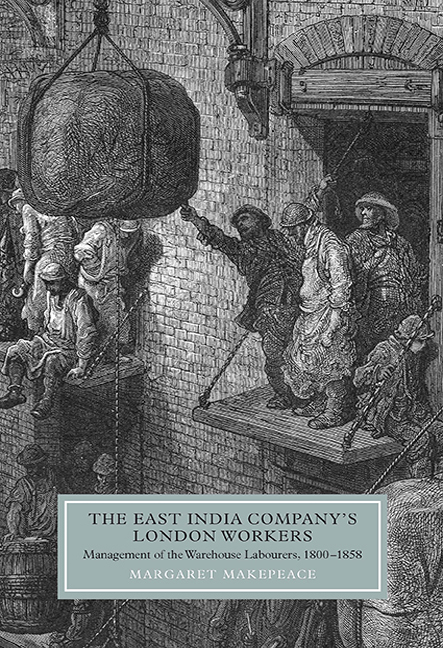Book contents
- Frontmatter
- Contents
- Figures and tables
- Dedication
- Acknowledgements
- Abbreviations
- 1 Introduction
- 2 The East India Company Warehouses
- 3 The Warehouse Labourers
- 4 Management Strategies: Incentives, Rewards and Benevolence
- 5 Management Strategies: Systems of Internal Control
- 6 The Royal East India Volunteers: The ‘Union of Civil and Military Dependence’
- 7 The Relationship Between the East India Company and its London Warehouse Labourers
- 8 The Warehouse Closures
- 9 Management of the Warehouse Labourers and Pensioners 1838–1858
- Conclusion: ‘Good Masters to the Lower Class of Their Dependents’
- Bibliography
- Index
9 - Management of the Warehouse Labourers and Pensioners 1838–1858
Published online by Cambridge University Press: 13 April 2017
- Frontmatter
- Contents
- Figures and tables
- Dedication
- Acknowledgements
- Abbreviations
- 1 Introduction
- 2 The East India Company Warehouses
- 3 The Warehouse Labourers
- 4 Management Strategies: Incentives, Rewards and Benevolence
- 5 Management Strategies: Systems of Internal Control
- 6 The Royal East India Volunteers: The ‘Union of Civil and Military Dependence’
- 7 The Relationship Between the East India Company and its London Warehouse Labourers
- 8 The Warehouse Closures
- 9 Management of the Warehouse Labourers and Pensioners 1838–1858
- Conclusion: ‘Good Masters to the Lower Class of Their Dependents’
- Bibliography
- Index
Summary
in september 1834 the East India Company London warehouse establishment consisted of 2291 men ranked from keeper to labourer, together with 281 pensioners. By October 1838, the balance of numbers between workers and pensioners had been reversed and there were 2246 men on the warehouse pension list. The Company now had to supervise only a small cohort of labourers but was faced with the task of managing a very large group of warehouse pensioners differing widely in age and scattered throughout the world. Moreover, the Company officials had to administer pensions operating under two different sets of rules: pensioners who retired before the compensation scheme came into operation were paid according to a less generous scale but were still entitled to be paid welfare benefits if they had been subscribers to the Labourers’ Fund. Charles Jones, who retired in 1825 on a pension of 5s per week, received payments on the birth of two children in 1836 and 1841, whilst William Walker, who retired in 1830 on a pension of 7s, received payments in 1836 for the birth of a child and the death of his wife, and at his death in December 1876 burial money of five guineas was paid to his daughters. Whereas the warehouse pension account for the whole year ending April 1834 amounted to £6489, the quarterly pension bill at Midsummer 1841 was approximately £9000. The number of pensioners did of course steadily decline as the men died: at Lady Day 1841 there were 1548 warehouse weekly pensioners on the books; by May 1852 there were only 903.
The labourers who remained in Company service after the cessation of commercial operations worked for the Military Store department which in 1835 had been consolidated with the cloth and stationery warehouses. The department was relocated in 1835 from Cutler Street to the former Company spice warehouse at 108 Leadenhall Street which had been specially converted. The cost of the alterations to the warehouses in Leadenhall Street amounted to £546 13s 4d, which was £14 17s 1d beyond the estimate because of the need to adapt old machinery removed from the earlier Military Store in Cutler Street.
- Type
- Chapter
- Information
- The East India Company's London WorkersManagement of the Warehouse Labourers, 1800–1858, pp. 183 - 194Publisher: Boydell & BrewerPrint publication year: 2010



